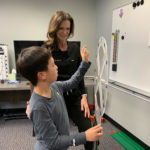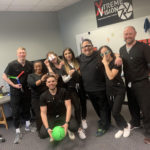
Dr. Voss with a patient. Dr. Voss says her vision therapy practice is both highly beneficial to patients and highly profitable.
By Ann W. Voss, Therapeutic Optometrist, FCOVD,
Diplomate, ABO
March 16, 2022
Early in my practice life, pediatrics and vision therapy became a passion of mine after receiving VT as a child myself and having a special needs brother who required extra services as well. Like any specialty, the success of it in your office will depend on your passion, skill and ability to create the operational environment for it to work.
I began offering vision therapy in the office I joined as an associate after graduating from University of Houston College of Optometry in 1989. I hired a part-time therapist, invested about $3,000 in start-up equipment and branded the therapy clinic as the Vision Learning Center (VLC). By 1998, I was ready to establish my own primary care practice and founded Bellaire Family Eye Care and brought the VLC with me.
Small Investment Can Launch a Vision Therapy Practice
The total space we initially leased was about 2,700 square feet, of which 300 square feet was for the VLC. Revenues for VT were $40,000 that first year with a part-time therapist and grew to $90,000 with two part-time therapists within two years. Equipment purchased early included basic hand-held equipment like vectograms and flippers, and I purchased the first visagraph, an eye movement recording device. Total budget with equipment and furnishings of the office space back then was $15,000-$20,000. Through the years we have added every new technology possible to provide premium services.
Other Articles to Explore
Over the years, the VLC outgrew the 300 square feet and moved to its own suite in the building, expanding first to 1,500 square feet and then a few years later to 3,000 square feet. Revenues have grown steadily from $40,000 in 1999 to over $800,000 per year in therapy alone. The growth was fueled by adding a new graduate in 2008, Marcia Moore, OD, (now a partner) who brought her own passion and enthusiasm for VT to the practice.
Additionally, we accomplished our growth by establishing a separate company entity for the VLC and made it a private-pay clinic. We could not figure out how to provide the quality of care on reimbursements from medical insurance, so splitting the VLC into its own company and Tax ID has worked beautifully.
A vision therapy practice is distinct from a traditional eyecare clinic in that there are virtually no costs of goods. Your primary overhead is the staff you hire to support your services. Forty-five percent of vision therapy fees in our office go to staff salaries; 9 percent to rent and 10-15 percent to other overhead costs like staff education and equipment. Our net profit is about 33 percent.
Build a Staff Parallel with Growth of Vision Therapy Patient Base
Revenues can only grow if you’re offering quality services from qualified staff. This is the greatest challenge in a VT practice, but one of the most rewarding as well. Begin with a passionate, committed therapist that you train and work alongside for a while, and then gradually add staff and create training modules for the new team. Eventually, the volume will be enough for the current therapists to train the new therapists. Continued training and education for the staff is a must. We devote every Wednesday morning to discussing the therapy plans of our patients and educating the team on new procedures and approaches to therapy. We work as a team, and the positive energy overflows into the therapy rooms.
Currently, we have five certified vision therapists through the College of Optometrists in Vision Development (COVD) and three developing therapists. In addition, we have two administrative staff members who enroll patients into VT, make appointments, and are liaisons between the doctors, therapists and families.
Provide Multiple Options Care & Payment Options
There are many areas that fall under the vision therapy umbrella. Some common diagnoses we treat are diplopia, convergence insufficiency, strabismus, amblyopia, eye movement disorders, post-concussion vision syndrome, visual-spatial disorders and many others. Sixty-five percent of our vision therapy patients are children, but adults are also a growing segment.

Dr. Voss’s team of vision therapists. Dr. Voss says a well-trained team to support a vision therapy niche is essential.
We have multiple programs to meet patients’ needs, including office-based, one-on-one therapy and home-therapy options. Our core program is 30 sessions of in-office therapy supplemented with at-home therapy using a kit with instructions that we provide. However, patients can opt for as few as six sessions. Fees are paid upfront for a reduced cost or paid per session.
As an out-of-network clinic we want to offer as many options as possible to make it possible for all patients to benefit from our services and treatments.
Market Your Vision Therapy Services
If you are launching vision therapy services in an established office, the key focus should be internal marketing to the other doctors in your practice and your current patient base.
You can also grow the practice by giving educational talks to schools and visiting local pediatrician offices, occupational therapy offices and other ODs’ offices.
Currently, we have a website, visionlearningcenter.com, set up especially for VLC, which can be reached on its own and via a link on our practice website.
We are often invited to speak at schools or occupational therapy practices to share information about vision and learning. We open our doors to any professional who wants to come learn from us and shadow for a day. One of the best ways to market your vision therapy services is to create a comprehensive report that shares your findings and recommendations. Make sure you share that report with the child’s pediatrician, school and anyone else participating in the patient’s care.
I am enormously proud of our office, all the services we provide and the difference our team makes. A specialty like vision therapy will enhance loyalty from your patients because you went the extra mile to help them.
 Ann W. Voss, Therapeutic Optometrist, FCOVD, Diplomate, ABO is a partner with Bellaire Family Eye Care (BFEC) in Houston, Texas. To contact her: Voss@bfeye.com
Ann W. Voss, Therapeutic Optometrist, FCOVD, Diplomate, ABO is a partner with Bellaire Family Eye Care (BFEC) in Houston, Texas. To contact her: Voss@bfeye.com





















